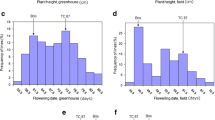Summary
With the objective of creating new combinations of disease resistance and quality, hybrids between wheat and spelt (spelt is well adapted to cool and wet conditions) were produced and the expression of heterosis was analysed. Three winter wheat varieties were crossed reciprocally with two spelt cultivars and the F1 hybrids were tested under artificial inoculation with stripe rust, powdery mildew and leaf rust. Disease susceptibility and quality characters (protein content, Zeleny value, grain hardness) were assessed in two year field trials. For stripe rust the F1 hybrids were resistant if one of the wheat parents was resistant. Combinations with the susceptible wheat cultivar ‘Arina’ were all susceptible irrespective of using a resistant spelt partner. Although the infection with powdery mildew was rather low, a similar reaction was obtained with the susceptible wheat variety ‘Bernina’. Leaf rust revealed very specific varietal influences. The two susceptible wheat varieties ‘Bernina’ and ‘Arina’ resulted in susceptible F1 hybrids when combined with a moderately resistant spelt. Only when they were crossed with a resistant spelt cultivar the F1 hybrids were resistant. ‘Forno’, a leaf rust resistant wheat, gave resistant F1 hybrids in all combinations. Without exception the quality characters tested showed a negative heterosis effect resulting in protein levels and Zeleny values close to or below the values of the lower parent. It appears to be possible to produce resistant F1 hybrids, mostly dominated by the resistance level of the wheat partner. The quality of the hybrids is mainly suitable for biscuit and spelt specific products; it needs specific screening for combinations with acceptable breadmaking quality.
Similar content being viewed by others
Abbreviations
- LSD:
-
Least Significant Difference
- RH:
-
Relative Heterosis
References
Barker, C.T. & G. Varughese, 1992. Combining ability and heterosis among eight complete spring hexaploid triticale lines. Crop Science 32: 340–344.
Borghi, B., M. Corbellini & M. Perenzin, 1987. Bread making quality of F1 hybrids produced using a chemical hybridising agent. In: B. Borghi (Ed.) Hard wheat: agronomic, technological, biochemical and genetic aspects. Commission of the European Communities, Luxembourg, 225–236.
Borghi, B., M. Perenzin & R.J. Nash, 1988. Agronomic and qualitative characteristics of ten bread wheat hybrids produced using a chemical hybridising agent. Euphytica 39: 185–194.
Borghi, B., M. Perenzin & R.J. Nash, 1989. Combining ability estimates in bread wheat and performance of 100 F1-hybrids produced using a chemical hybridising agent. J. Genet. & Breed. 43: 11–16.
Brears, T. & J. Bingham, 1989. Exploitation of heterosis in hybrid wheat using gametocides. Vorträge für Pflanzenzüchtung 16: 397–409.
Brears, T., A.G. Hydon & J. Bingham, 1988. An assessment of the feasability of producing F1 and F2 hybrids for the U.K. In: T.E. Miller & R.M.D. Koebner (Eds) Proceedings of the Seventh Int. Wheat Genetics Symposium, 1988, IPSR Cambridge, 1057–1062.
Brown, C.M., R.O. Weibel & R.D. Seif, 1966. Heterosis and combining ability in common winter wheat. Crop Science 6: 382–383.
Done, A.A., 1973. Implications of the introduction of hybrid cereals on disease patterns. Annals of Applied Biology 75: 144–149.
Hron, R., 1976. Microtrials in Austria concerning heterosis in winter wheat. In: A. Janossy & F.G.H. Lupton (Eds) Heterosis in Plant Breeding, Proceedings of the seventh congress of EUCARPIA, Elsevier 161–167.
Johnson, R. & F.G.H. Lupton, 1987. Breeding for disease resistance. In: F.G.H. Lupton (Ed.) Wheat breeding, its scientific basis. Chapman & Hall, 367–424.
Jost, M. & C.F. Hayward, 1980. F1 hybrids versus 32 selected F7 lines performance of common winter wheat (Triticum aestivum ssp. vulgare). Theoretical and Applied Genetics, 57: 177–180.
Keydel, F., 1973. Untersuchungen über die Leistungseigenschaften von F1-Hybriden von Winterweizen. Zeitschr Pflanzenzüchtung 69: 239–255.
Merfert, W. & S. Sander, 1982. Hybridweizen und Hybrid-effekt. Archiv für Züchtungsforschung 12: 235–244.
Merfert, W., E. Koch & S. Sander, 1983. Hybridweizen und Saatgut-produktion. Archiv für Züchtungsforschung 13: 237–246.
Morgan, C.L., R.B. Austin, M.A. Ford, J. Bingham, W.J. Angus & S. Chowdhury, 1989. An evaluation of F1 hybrid winter wheat genotypes produced using a chemical hybridising agent. J. Agric. Sci. Canb. 112: 143–149.
Oury, F.X., P. Brabant, P. Pluchard, P. Berard & M. Rousset, 1990a. Etude multilocal de blés hybrides; niveau d'hétérosis et élaboration du rendement. Agronomie 10: 735–748.
Oury, F.X., J. Koenig, P. Berard & M. Rousset, 1990b. Une comparaison entre des blés hybrides produits par voie chimique et leurs parents: niveaux d'hétérosis et élaboration du rendement. Agronomie 10: 291–304.
Perenzin, M., N.E. Pogna & B. Borghi, 1992. Combining ability for breadmaking quality in wheat. Can. J. Plant Sci. 72: 743–754.
Pickett, A.A., 1993. Hybrid wheat-Results and problems. Advances in Plant Breeding 15, pp 259. Paul Parey Scientific Publishers.
Schmid, J.E. & H. Winzeler, 1990. Genetic studies of crosses between common wheat (Triticum aestivum L.) and spelt (Triticum spelta L.). J. Genetics & Breeding 44: 75–80.
Shebeski, L.H., 1966. Quality and yield studies in hybrid wheat (Triticum aestivum L.). Canadian Journal of Genetics and Cytology 8: 375–386.
Wilson, P. & C.J. Driscoll, 1983. Hybrid wheat. In: R. Frankel (Ed.), Heterosis, reappraisal of theory and practice. Monographs on Theoretical and Applied Genetics 6: 94–123.
Winzeler, H., M. Winzeler & J.E. Schmid, 1991. Vererbung verschiedener Merkmale von Dinkel (Triticum spelta L.) und Weizen (Triticum aestivum L.). Landw. Schweiz 4(8): 443–447.
Winzeler, H., J.E. Schmid & M. Winzeler, 1994. Analysis of the yield-potential and yield-components of F1 and F2 hybrids of crosses between wheat (Triticum aestivum) and spelt (Triticum spelta). Euphytica (submitted).
Zeven, A.C., 1972. Plant density effect on expression of heterosis for yield and its component in wheat and F1 vs. F3 yields. Euphytica 21: 468–488.
Author information
Authors and Affiliations
Rights and permissions
About this article
Cite this article
Schmid, J.E., Winzeler, M. & Winzeler, H. Analysis of disease resistance and quality characters of F1 hybrids of crosses between wheat (Triticum aestivum) and spelt (Triticum spelta). Euphytica 75, 105–110 (1994). https://doi.org/10.1007/BF00024537
Received:
Accepted:
Issue Date:
DOI: https://doi.org/10.1007/BF00024537



